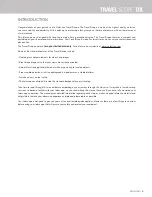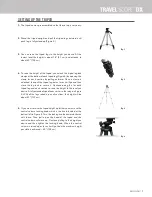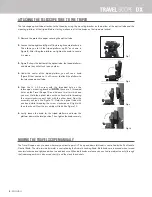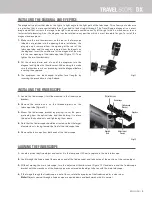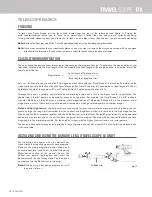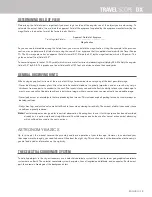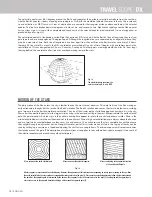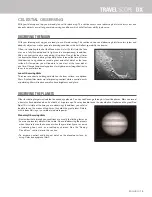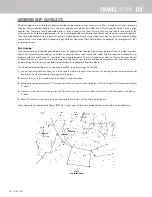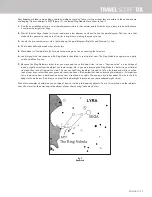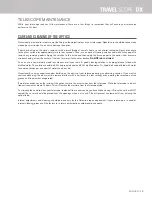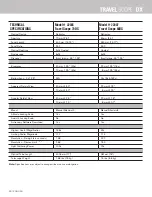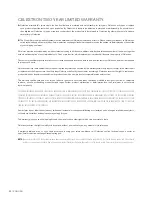
ENGLISH
I
13
DETERMINING FIELD OF VIEW
Determining the field of view is important if you want to get an idea of the angular size of the object you are observing To
calculate the actual field of view, divide the apparent field of the eyepiece (supplied by the eyepiece manufacturer) by the
magnification In equation format, the formula looks like this:
Apparent Field of of Eyepiece
True Angular Field
=
________________________________
Magnification
As you can see, before determining the field of view, you must calculate the magnification Using the example in the previous
section, we can determine the field of view using the same 20 mm eyepiece that is supplied standard with the Travel Scope
70 The 20 mm eyepiece has an apparent field of view of 50° Divide the 50° by the magnification, which is 20 power This
yields an actual (true) field of 2 5°
To convert degrees to feet at 1,000 yards (which is more useful for terrestrial observing) multiply by 52 5 Multiply the angular
field of 2 5° by 52 5 This produces a linear field width of 131 feet at a distance of one thousand yards
GENERAL OBSERVING HINTS
When using any optical instrument, there are a few things to remember to ensure you get the best possible image
• Never look through window glass Glass found in household windows is optically imperfect, and as a result, may vary in
thickness from one part of a window to the next This inconsistency can and will affect the ability to focus your telescope In
most cases you will not be able to achieve a truly sharp image, while in some cases you may actually see a double image
• Never look across or over objects that are producing heat waves This includes asphalt parking lots on hot summer days or
building rooftops
• Hazy skies, fog, and mist can also make it difficult to focus when viewing terrestrially The amount of detail seen under these
conditions is greatly reduced
Note:
Your telescope was designed for terrestrial observation Knowing how to use it for this purpose has been described
already as it is quite simple and straightforward Your telescope can also be used for casual astronomical observing
which will be discussed in the next sections
ASTRONOMY BASICS
Up to this point, this manual covered the assembly and basic operation of your telescope However, to understand your
telescope more thoroughly, you need to know a little about the night sky This section deals with observational astronomy in
general and includes information on the night sky
THE CELESTIAL COORDINATE SYSTEM
To help find objects in the sky, astronomers use a celestial coordinate system that is similar to our geographical coordinate
system here on Earth The celestial coordinate system has poles, lines of longitude and latitude, and an equator For the most
part, these remain fixed against the background stars
Содержание 22007
Страница 1: ...INSTRUCTION MANUAL Models 22007 60 DX 22035 70 DX ENGLISH DX ...
Страница 2: ......
Страница 4: ...4 I ENGLISH ...
Страница 21: ...ENGLISH I 21 NOTES ...
Страница 24: ...MANUEL DE L UTILISATEUR Modèle n 22007 60 DX n 22035 70 DX FRANÇAIS LONGUE VUE DE VOYAGE ...
Страница 25: ......
Страница 27: ...4 I FRANÇAIS ...
Страница 44: ...FRANÇAIS I 21 NOTES ...
Страница 47: ...BEDIENUNGSANLEITUNG Modell 22007 60 DX 22035 70 DX DEUTSCH REISETELESKOP ...
Страница 48: ......
Страница 50: ...4 I DEUTSCH ...
Страница 67: ...DEUTSCH I 21 HINWEISE ...
Страница 70: ...MANUALE DI ISTRUZIONI Modello n 22007 60 DX n 22035 70 DX ITALIANO TELESCOPIO DA VIAGGIO ...
Страница 71: ......
Страница 73: ...4 I ITALIANO ...
Страница 90: ...ITALIANO I 21 NOTE ...
Страница 93: ...MANUAL DE INSTRUCCIONES Modelo Nº22007 60 DX Nº22035 70 DX ESPAÑOL TELESCOPIO PARA VIAJES ...
Страница 94: ......
Страница 96: ...4 I ESPAÑOL ...
Страница 113: ...ESPAÑOL I 21 NOTAS ...





